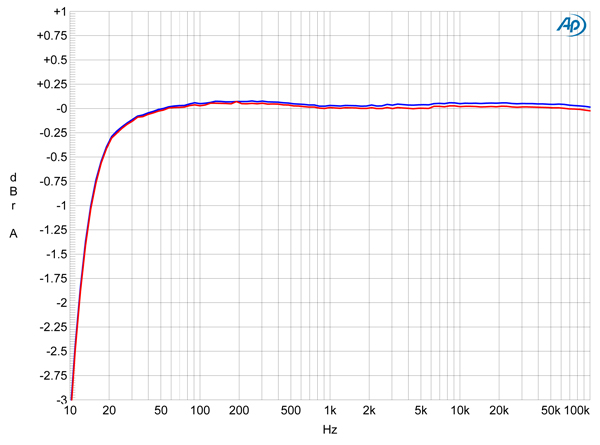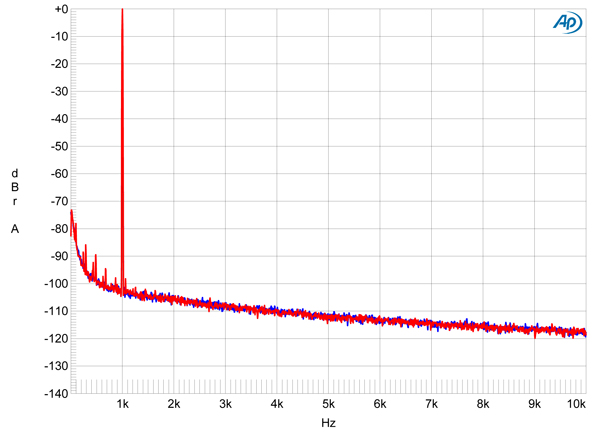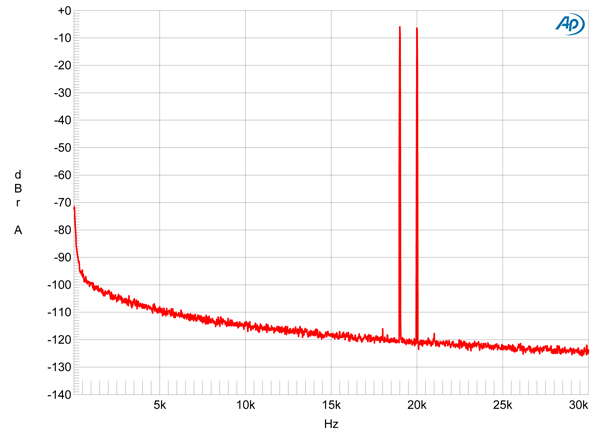| Columns Retired Columns & Blogs |
Seta Model L phono preamplifier John Atkinson, December 2013
John Atkinson reviewed Channel D's Seta Model L in December 2013 (Vol.36 No.12):
New Jersey–based Channel D, best known for its Pure Music and Pure Vinyl programs for Apple computers, also offers a couple of hardware products. Michael Fremer reviewed Channel D's Seta Model L, a battery-powered, solid-state phono preamplifier, in the August 2010 issue. The basic Seta L costs $3799 (footnote 1) and includes balanced and single-ended inputs, balanced unequalized outputs, switchable gain, and a built-in power supply based on rechargeable batteries. An $1199 option adds RIAA correction for both balanced and single-ended outputs.
Michael was impressed by what he heard from the Channel D preamp: "[T]he Model L is a quiet, remarkably neutral-sounding, extremely well-built phono preamplifier capable of excellent low-level resolution. . . . Recordings made using the Seta Model L's RIAA-equalized outputs were models of clarity, definition, tonal accuracy, detail resolution, and spatial coherence." I have been trying out different phono preamps since I began using the Ayre Acoustics QA-9 A/D converter to rip LPs to 24-bit/192kHz PCM files and as the Seta L offers both conventional RIAA-equalized outputs and unequalized, flat outputs, the latter to allow RIAA EQ to be applied in the digital domain by Pure Vinyl, I asked Channel D's Rob Robinson for a review sample.
Robinson was willing, as it turned out that he'd belatedly discovered that the original unit tested had a malfunction that kept it from going completely off the grid when running on battery power. "There have been numerous other improvements in production and two circuit-board revisions since then, as well as improved isolation in battery mode," he wrote, adding that this all added up to "Better performance!"
Before auditioning the new Seta L, I ran it through my usual test routine to ensure that it was working properly. The batteries were fully charged for the testing, though the preamplifier still needs to be connected to its wall-wart DC supply when in use. (It powers the signal switching relays.) I used Stereophile's loan sample of the Audio Precision SYS2722 system (see the January 2008 "As We See It" and www.ap.com), and, as I was going to use the Seta's RIAA-equalized outputs for this Follow-Up, I restricted this set of measurements to those.
The Seta Model L offers four choices of gain: 43, 46, 49, and 53dB from its Flat outputs, with an additional 12dB available from its RIAA outputs for each of these. The selected gain is indicated by a front-panel LED respectively lighting up light blue, blue, violet, or lavender. With the Seta L set to its highest input impedance and using its balanced input, I measured gains of 53.4, 56.3, 59.2, and 63dB from its balanced RIAA jacks. The Seta L preserved absolute polarity from those outputs, with, at all audio frequencies, very low output impedances of 40 ohms balanced and 20 ohms single-ended. Set at 100 ohms, the input impedance was 102 ohms balanced and 100 ohms single-ended, these values maintained from 200Hz to 20kHz.

Fig.1 Channel D Seta Model L, response with RIAA correction and infrasonic high-pass filter (left channel blue, right red) (0.5dB/vertical div.).
The Seta L's RIAA accuracy is shown in fig.1. The channels match superbly well, and any departure from perfect RIAA de-emphasis is 0.05dB or less up to the graph's 100kHz limit. This is significantly better than both of the samples I measured at the time of MF's review. The low frequencies start to roll off below 50Hz, reaching –0.3dB at 20Hz and –3dB at 10Hz. This is the action of the preamplifier's high-pass filter, which can be deactivated with internal jumpers if desired. Internal jumpers can also be used to set the so-called "Neumann Fourth Pole" correction, which boosts the output above the audioband. I haven't shown this in fig.1, as I am philosophically opposed to correcting something that, in my opinion, doesn't need fixing.
As with the 2010 samples, the new Seta L's channel separation was excellent, at 90dB in both directions for the RIAA-equalized outputs. With the RIAA-output gain set to the maximum 63dB, the wideband, unweighted signal/noise ratio, ref. 1kHz at 500µV and taken with the input shorted, was an okay 54.9dB left and 54.2dB right. These ratios improved to 64.7 and 64.5dB when A-weighted, and improved by 3dB or so for every reduction in the gain setting. While this is not as deathly quiet as the solid-state Liberty B2B-1 ($1749)—which, until the arrival of the Channel D, had the best RIAA accuracy I had encountered—it is still sufficiently quiet for LPs to be played with black backgrounds. For example, on too many LPs in my collection, the sound of the cutting lathe's setscrew advancing the cutter head between tracks is much higher in level than the Seta L's self-noise. Putting my ear against the Wilson Audio Specialties Alexia speakers with the preamp volume set higher than I usually use, all I could hear was very low-level pink noise. And no hum, of course.

Fig.2 Channel D Seta Model L, balanced RIAA output, spectrum of 1kHz sinewave, DC–10kHz, at 2V into 100k ohms (linear frequency scale).
The earlier samples of the Seta L were superbly linear, and the 2013 sample was no different. Fig.2 shows the spectrum of the RIAA outputs with a 1kHz tone at 2V into 100k ohms. With the maximum preamp gain, this is equivalent to an input 10dB above the nominal reference level for a moving-coil cartridge of 500µV. Nevertheless, no distortion harmonics are visible above the noise floor. (This floor slopes down from left to right, due to the RIAA de-emphasis.) The results with intermodulation distortion were similarly superb.

Fig.3 Channel D Seta Model L, balanced RIAA output, HF intermodulation spectrum, DC–24kHz, 19+20kHz at 2V peak into 100k ohms (linear frequency scale; left channel blue, right red).
An equal mix of 19 and 20kHz tones, with a signal level again 10dB above the nominal MC reference level, was reproduced with no 1kHz difference tone visible above the noise floor—and, at 18 and 21kHz, spuriae that were merely vestigial at almost –120dB (fig.3).
Sound Quality
Time to do some listening. (Click here for details of the system used.) As my Linn Ekos tonearm has unbalanced output cables, I set the Seta L's internal jumpers to Single-Ended, which connects pin 3 of the input XLRs to ground. Independent rotary switches on the Seta's rear panel allow the input impedance to be adjusted from 25 ohms to 2k ohms; I selected 100 ohms for my Linn Arkiv B cartridge. There is also a trimpot that allows the channel balance to be adjusted by up to 2dB. The Arkiv B's right channel was slightly quieter than the left, so I adjusted for this using the tones on Denon's set of test LPs. I left the Seta L's infrasonic filter in place, as recommended by Rob Robinson, and ignored the Neumann RIAA modification.
"Clean, clear, detailed, open," read my auditioning notes with every LP I played. But this didn't mean that the Seta L was emphasizing high-frequency detail. Instead, the detail was there when I listened for it, just as occurs with live sound, but without the rolled-off highs produced by some phono preamps that also excel in this area. There was no treble spotlighting—LP clicks and ride cymbals weren't emphasized—and the midrange sounded just right. The smoky tones of Patricia Barber's voice in "The Thrill Is Gone," from Jim Anderson's superb remix for vinyl of her Café Blue (2 LPs, Premonition/Blue Note 90760-1), sent goose bumps down my spine. Her piano solo was crystalline in its clarity, with just a frisson of superbly resolved ambience surrounding its image.
Low frequencies were well defined, if lacking the ultimate weight that they have through the megabux phono preamplifiers I've listened to at Michael Fremer's. (Yes, those experiences have been with different speakers, different amplification, and a different LP player. But I come away from Mikey's impressed by the consistent authority of the low frequencies with the better phono preamps.) Even so, the pedal line in Vaughan Williams's setting for organ of the Welsh hymn tune "Rhosymedre," in the performance by Philip Ledger on Organ Music from King's (LP, EMI HQS-1356), had the appropriate weight. The double bass in "The Thrill Is Gone" sounded superbly clear, with enough of a purr to the body of its tone to support the song's harmonic structure.
The phono preamp I'd been using before the Seta Model L's arrival was the excellent Liberty B2B-1. The B2B-1 had already been returned to the manufacturer, but I had a library of 24/192 LP needle-drops that I'd created using the Liberty and the inexpensive Vinyl Studio program. It was a straightforward task to duplicate some of those rips using the Seta L's RIAA-equalized outputs to feed the Ayre QA-9, match the peak levels, and compare the files with Pure Music.
There was a tad more midbass energy in the Liberty transfer of "Putting On the Ritz," from Peter Skellern's Astaire (24/192 AIFF from Mercury 9109 702), though the two files were very similar above that region. Similarly, the late Radka Toneef's interpretation of Jimmy Webb's "The Moon Is a Harsh Mistress," from Toneef's Fairytales (24/192 AIFF from Odin LP03), was breathtakingly delicate through both phono preamplifiers.
But after several sets of comparisons, I felt the Seta Model L had a slight advantage in preserving recorded ambience. The soundstage widths were identical with all the needle drops I compared, but there was a touch more soundstage depth with the Channel D. My litmus test for this aspect of performance is "Die Tänzerin," from Ulla Meinecke's 1983 album, Wenn Schon Nicht für Immer, dann Wenigstens für Ewig (German LP, RCA 426124). The sparse arrangement on this track—female voice, electronic keyboard, drum machine, finger snaps—allows the quantity and quality of the reverberation used to be readily perceived. And as artificial as the soundstage might be on this studio recording, again, the Seta Model L threw a slightly deeper stage than the Liberty.
It's an understatement to say that I was impressed by the Seta Model L used as a conventional RIAA preamplifier. It measured more like a piece of laboratory equipment than a typical high-end component, and sounded superb to boot. Michael Fremer had also been impressed, particularly when ripping LPs using the preamplifier's Flat outputs and applying the RIAA de-emphasis with Channel D's Pure Vinyl program. That will be the subject of my next Follow-Up on this preamplifier.—John Atkinson
Footnote 1: The Seta Model L is sold direct. Channel D, Lambertville, NJ. Tel: (609) 818-0700. Web: www.channld.com.
- Log in or register to post comments




































